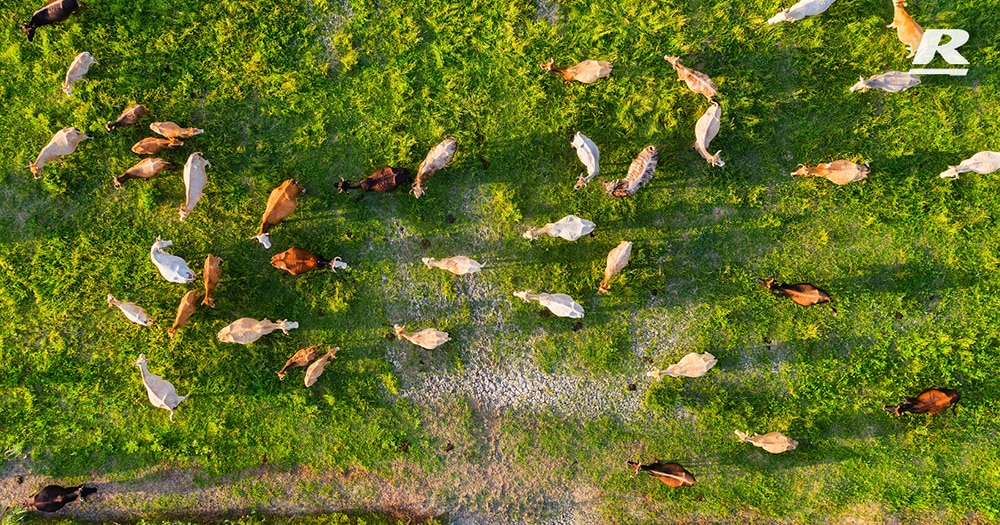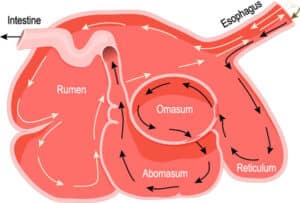Sub Acute Ruminal Acidosis (SARA)
A well-functioning rumen is crucial to cow health and performance. Cow feeding fermentable carbohydrates drives production, but it can also increase the likelihood of sub-acute ruminal acidosis (SARA). SARA is one of the most significant health disorders that occurs in ruminants fed high quality pastures and concentrates. Maintaining a stable rumen environment can reduce the incidence of SARA. Lameness, diarrhea, a drop in dry matter intake (DMI), and low milk fat test (and yield) may be observed in herds experiencing SARA.
What is SARA?
Sub-acute ruminal acidosis is caused by an accumulation of volatile fatty acids (VFA) in the rumen, predominantly propionate. Excessive VFA accumulation drops rumen pH, reduces the efficiency of the fibre-digesting microbes and impacts microbial protein production. SARA is characterised by a rumen pH below 5.8, whereas normal/optimal rumen pH is in the range of 5.9-6.1 for dairy cows.
What causes SARA?
When ruminants ingest fermentable carbohydrates (ie. starchy grains), the rumen microbes break these down and produce VFAs. In a well-balanced diet, VFAs are readily absorbed by the papillae across the rumen wall, and enter the bloodstream to be used for milk production. However, when VFA production exceeds the threshold ability of the ruminal papillae to absorb them, the VFAs accumulate in the rumen which in turn causes the rumen pH to drop.
What are the signs your herd is being affected by SARA?
Typically, cows that have SARA will have liquid faeces (scours) containing undigested fibre and grain, and manure is often lighter in colour. There is also a correlation between low ruminal pH and reduced milk fat concentration. Milk fat test and yield can also be influenced by stage of lactation, dietary fat content, and body fat mobilisation; therefore, milk fat yield is not always associated with SARA. If there is a rapid drop in milk fat of 0.3-0.5%, or if milk protein drops by more than 0.3% within a week, then this needs to investigated, especially if the fat test drops below the protein test.
How can REIDS help?
The most common cause of SARA is from an unbalanced diet. This can come from many factors such as insufficient fibre, lack of effective fibre, or a high proportion of non-fibre carbohydrates (NFCs) in the diet. If effective fibre is lacking or the fibre particle sizes are too small, rumination and saliva production can be inhibited. The bicarbonate in saliva is used to buffer the rumen and stabilise rumen pH. The rule of thumb is when 50% or more of the herd are cud chewing outside of grazing and milking time, they have healthy rumen function. The easiest place to observe this is in the paddock after cows have had a few hours to graze. The action of cud chewing stimulates the flow of saliva and buffers to the rumen to stabilise the pH.
Reid’s can help you create a well-balanced diet for your herd by implementing the following strategies:
- It is recommended that diets are balanced to 35-40% NFCs of the total diet DM. Different sources of NFCs digest at different rates in the rumen, so this should be considered when formulating rations e.g. Consider the fermentation rates of your starch sources.
- Cows should have access to good quality hay or straw when pastures are lush. The overall diet should sit around 28-32% NDF, and at least 80% of the NDF should be from long/effective fibre.
- The use of rumen buffers such as sodium bicarbonate fed at a rate of 0.75% of total ration dry matter also help to reduce the acid load in the rumen.
- Incidence of SARA can increase after calving due to the diet change. Cows are generally fed a high NDF diet during their dry period compared to what they receive during lactation. A sudden shift from a high fibre diet (dry cows) to a lower fibre/high concentrate diet (lactation) often impacts rumen function and increase cows’ risk of developing SARA. Feeding a transition diet for at least 3 weeks prior to calving will help microbial populations in the rumen adjust to fermentable concentrates.

